4.30.2008
seasonal
This morning, I woke up to this:
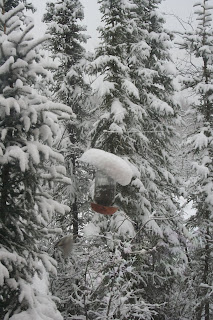 Technically, it is still April. But May is less than 24 hours away. The snowplows are scraping along on the road outside the cabin. For my part, I'm eyeing my skis and wondering if there is enough pack on the recently thawed trails for a last horrah.
Technically, it is still April. But May is less than 24 hours away. The snowplows are scraping along on the road outside the cabin. For my part, I'm eyeing my skis and wondering if there is enough pack on the recently thawed trails for a last horrah.
4.28.2008
preparation
Sunday's Fire Medic training was much improved. Our sponsoring doctor came in to discuss protocols and standing orders. We played with pigs feet, cleaning out nasty contaminated wounds with days of transport time and swelling between them and definitive care. We poked around one another's ears and eyes with examination tools. One of the lecturers from last month's EMS symposium came in and gave another excellent presentation on orthopedic injuries. Department folk were a little less standoffish this go round. My falafel and hummus was spectacular, and I spent lunch hanging out with another department medic's dog Quark in the parking lot and chatting with Pete on the phone. Much better company.
One of the things I am most excited about with the Fire Medic program is that we have protocols and training that allow us to do a fair bit more care than our state EMT levels allow. The reasons are twofold. On a fire line, we are doing significant preventative treatment to keep fire crews healthy and mobile and on the fire. On the remote wildfires in Alaska and in a lot of western states (Idaho, Montana) transport times for significantly sick, burnt or otherwise wounded firefighters can be days, not hours. We have to be able to provide more significant, long term pre-hospital care to prevent complications later down the line. I think this summer will be an invaluable learning experience as an aspiring paramedic.
In other news, I passed the forestry pack test tonight with over three minutes to spare and three firefighters behind me. I was barely out of breath. I was elated. Hauling fifty pounds of sand up and down my neighborhood hills for the last several weeks has paid off. I even spent the last leg of the test chatting with a firefighter about his day-job as a 747 pilot and his dog team.
Back to the dog kennel tomorrow. Despite waking up to snow every morning for the last four days, things are clicking along towards spring.
One of the things I am most excited about with the Fire Medic program is that we have protocols and training that allow us to do a fair bit more care than our state EMT levels allow. The reasons are twofold. On a fire line, we are doing significant preventative treatment to keep fire crews healthy and mobile and on the fire. On the remote wildfires in Alaska and in a lot of western states (Idaho, Montana) transport times for significantly sick, burnt or otherwise wounded firefighters can be days, not hours. We have to be able to provide more significant, long term pre-hospital care to prevent complications later down the line. I think this summer will be an invaluable learning experience as an aspiring paramedic.
In other news, I passed the forestry pack test tonight with over three minutes to spare and three firefighters behind me. I was barely out of breath. I was elated. Hauling fifty pounds of sand up and down my neighborhood hills for the last several weeks has paid off. I even spent the last leg of the test chatting with a firefighter about his day-job as a 747 pilot and his dog team.
Back to the dog kennel tomorrow. Despite waking up to snow every morning for the last four days, things are clicking along towards spring.
4.26.2008
reality
I woke up early this morning to attend the first of four training days for the Alaska Wildland Fire Medic program. On Monday, I will take the pack test - and endurance test that is one of two steps in earning my Red Card. In May, I will complete my Red Card requirements by passing four days of Emergency Fire Fighter training, and in doing so be given a green light to work on any wildfire line in the country. In June, when the fires start, I will hope for a call telling me that I have two hours to be at the helipad on the local army base to meet a lead medic and four hundred pounds of medical equipment. All summer, I hope to be camping in the smoldering taiga treating burns and dehydration and blisters and intestines plugged up by too many MREs. And maybe a cool chainsaw wound or two or three.
Sounds cool, right? But in order to pull this off, I have had to reign back my already dwindling kennel hours, despite the lack of training pay for the summer. I have also had to reschedule things with the Little Tour Company, where I am helping prepare a new crop of guides for their commercial driving test. I have had to do this a few too many times this week, as non-negotiable fire trainings keep getting shifted around. I am afraid that I am blowing my good will and credibility with the tour company and my friends there - especially the friend who helped me snag this training position. Also, around fire fighters at the station and medics at the training, the language and talk is loud and rough. Kayak guiding and deck handing onResurrection Bay and working in a shelter in Chicago
Then there is the reality of Fire Medic training itself. This first day consisted of fire-medics showing cool slides of flames in trees, billowing smoke and pretty vistas they have camped in while waxing on about this fire line and that fire camp and how much it rains and floods and how dark smoke is. Interspersed between these slide shows were acronym strewn arguments about the politics of helicopter procedures, ICS structure and lower 48 crews and assignments. These heated conversations meant nothing to me. I felt like Charlie Brown when the grownups talk. We only got to relevant medical stuff (debriding burns, dealing with AMS, how the pounds and pounds of gear is allocated) in the last couple of hours of a long day. Already over an hour behind schedule, it was given short shrift.
In addition, although the majority of those at the training were from my fire department, there was a clear inner circle of veterans of the program. I felt my friendly hellos rebuffed by folks I have been working and training with since January. It stung, and I got a little pissed. Although I packed a lunch to eat (peter made hummus and falafel, horrah!) I decided to cough up lunch money to eat with the group at the mess hall on base. I thought the cold shoulders of the morning were perhaps due to a lack of coffee. I was wrong. It was elementary school lunch all over again - both in food quality and cool-kid table politics. I could hardly believe what was happening. I will be eating my own pita bread tomorrow.
When I got home, I threw on my training pack and slogged around the neighborhood in the break-up mud. Peter and Nyssa came along for moral support. I have two days till the pack test and I am terrified of failing, especially in front of department captains and firefighters I'm trying to gain credibility with. By the time we got back to the house, snow had started spitting again. Is it going to be a long weekend.
Sounds cool, right? But in order to pull this off, I have had to reign back my already dwindling kennel hours, despite the lack of training pay for the summer. I have also had to reschedule things with the Little Tour Company, where I am helping prepare a new crop of guides for their commercial driving test. I have had to do this a few too many times this week, as non-negotiable fire trainings keep getting shifted around. I am afraid that I am blowing my good will and credibility with the tour company and my friends there - especially the friend who helped me snag this training position. Also, around fire fighters at the station and medics at the training, the language and talk is loud and rough. Kayak guiding and deck handing on
Then there is the reality of Fire Medic training itself. This first day consisted of fire-medics showing cool slides of flames in trees, billowing smoke and pretty vistas they have camped in while waxing on about this fire line and that fire camp and how much it rains and floods and how dark smoke is. Interspersed between these slide shows were acronym strewn arguments about the politics of helicopter procedures, ICS structure and lower 48 crews and assignments. These heated conversations meant nothing to me. I felt like Charlie Brown when the grownups talk. We only got to relevant medical stuff (debriding burns, dealing with AMS, how the pounds and pounds of gear is allocated) in the last couple of hours of a long day. Already over an hour behind schedule, it was given short shrift.
In addition, although the majority of those at the training were from my fire department, there was a clear inner circle of veterans of the program. I felt my friendly hellos rebuffed by folks I have been working and training with since January. It stung, and I got a little pissed. Although I packed a lunch to eat (peter made hummus and falafel, horrah!) I decided to cough up lunch money to eat with the group at the mess hall on base. I thought the cold shoulders of the morning were perhaps due to a lack of coffee. I was wrong. It was elementary school lunch all over again - both in food quality and cool-kid table politics. I could hardly believe what was happening. I will be eating my own pita bread tomorrow.
When I got home, I threw on my training pack and slogged around the neighborhood in the break-up mud. Peter and Nyssa came along for moral support. I have two days till the pack test and I am terrified of failing, especially in front of department captains and firefighters I'm trying to gain credibility with. By the time we got back to the house, snow had started spitting again. Is it going to be a long weekend.
4.19.2008
warm
4.16.2008
911 - 101
In my last five shifts at the station, I have not had a single call - not even to stand around with my hands in my pockets while the firefighters put out a dumpster blaze. As happy as I am that nobody is getting hurt (or abusing the system) in our district, I'm also a little frustrated at the rust that's starting to build up on the edges of my brand-spanking-new skills. Also, there seem to be plenty of calls when I'm not around ... so maybe I have some bad karma I need to work off.
In the mean time, I've been thinking about my first few calls and the steep learning curve I'm traveling towards having any sort of clue about what I'm doing back there in the box. They are things I'd like to remember when these first days of stumbling through the adrenaline and jitters of lights-and-sirens are through.
Call One, Lesson One -
Just because you could manhandle the gurney into and out of the ambulance in training does not mean you'll remember which lever to push and which way to pull when there is a patient sitting on a stair chair in the snow waiting for it.
Homework - Spend the medic's paperwork time in the hospital ambulance bay manhandling the gurney within an inch of its life. Then do it again at the station. And again in the bay. And again at the station. Until you can do it blindfolded.
Call One, Lesson Two -
If the troopers are there and the place has been torn to pieces, look before you kneel. Especially in the kitchen.
Call Two, Lesson One -
If the tones go off at five am for a bravo response, pee first.
Homework - The third time it happens should be the last, right?
Call Two, Lesson Two -
Have the bandaid out before you stick for glucose. Put the bandaid on while you wait for the reading. Because the reading takes just long enough for the tiny little finger stick to bleed all over the floor.
Call Three, Lesson One -
Just because you got checked off on what is where in the ambulance a month ago doesn't mean you won't grab the Pedi-MAST pants that live next to the O2 bag - instead of the Pedi Jump-Kit by the back doors - on your first Pedi call. Thank the EMS gods it wasn't serious, and never, ever make that mistake again.
Homework - Get out the inventory sheet and do inventories of every ambulance, every shift until you can pinpoint everything - even ALS drugs and gear - in your sleep.
Call Three, Lesson Two -
Have extra penlights in the Pedi-kit. They make spectacular toys/distractions and you don't have to make the kid scream my taking them back when you leave. Because the kid will scream when you take away the neat inflatable cuff.
Call Four, Lesson One -
Just because the patient ambulates himself to the ambulance doesn't mean he won't crash before you get to the end of the road.
Call Four, Lesson Two -
Grand Mal Seizures look scary on the cardiac monitor. Focus on the patient, not the monitor.
Call Four, Lesson Three -
If you take a pressure when the medic is sticking the patient in her other arm and the patient is screaming her head off about it, you will get a high reading.
Homework - Run Review: The elevated pressure had nothing to do with the impending seizure. Neither did the chest pain, although that's what got her a fast pass into open heart surgery.
Call Five, Lesson One -
If you get on scene and an EMT you don't trust is already there making an ass of themselves, a good lead medic will get them the hell away from the patient. Especially if the patient is critical. Homework - Do everything you can think of to make your lead medic happy for the rest of that shift, and the next shift, and the next shift, ad infinitum.
Call Five, Lesson Two -
If a spouse passes you a bucket of blood when you walk in the door and tells you it is the second one being worked on by your vomiting patient, expect to run hot. But watch and learn as Star Lead gets a solid history and exam before moving them, while the patient is still talking. Because two buckets means the patient won't be talking for long.
Call Five, Lesson Three -
Contrary to what they taught you in class, if there is only blood in the bucket the ER staff doesn't need or want to see it. Don't bring it. It will piss off the nurse you hand it to, and it's not worth the risk of covering the ambulance floor when the bucket tips. A good volume estimation goes a long way.
Call Five, Lesson Three -
If you focus on the skills you know and do those things fast and well, you'll have done everything you can for the critical patient - even if you are still too jittery to take a step back mid-call and see just how critical that patient is.
Take Home - Practice what you know, and let the lead medics worry about how critical patients are. The ability to see the big picture - and act on it - in the middle of a crazy call will come.
In the mean time, I've been thinking about my first few calls and the steep learning curve I'm traveling towards having any sort of clue about what I'm doing back there in the box. They are things I'd like to remember when these first days of stumbling through the adrenaline and jitters of lights-and-sirens are through.
Call One, Lesson One -
Just because you could manhandle the gurney into and out of the ambulance in training does not mean you'll remember which lever to push and which way to pull when there is a patient sitting on a stair chair in the snow waiting for it.
Homework - Spend the medic's paperwork time in the hospital ambulance bay manhandling the gurney within an inch of its life. Then do it again at the station. And again in the bay. And again at the station. Until you can do it blindfolded.
Call One, Lesson Two -
If the troopers are there and the place has been torn to pieces, look before you kneel. Especially in the kitchen.
Call Two, Lesson One -
If the tones go off at five am for a bravo response, pee first.
Homework - The third time it happens should be the last, right?
Call Two, Lesson Two -
Have the bandaid out before you stick for glucose. Put the bandaid on while you wait for the reading. Because the reading takes just long enough for the tiny little finger stick to bleed all over the floor.
Call Three, Lesson One -
Just because you got checked off on what is where in the ambulance a month ago doesn't mean you won't grab the Pedi-MAST pants that live next to the O2 bag - instead of the Pedi Jump-Kit by the back doors - on your first Pedi call. Thank the EMS gods it wasn't serious, and never, ever make that mistake again.
Homework - Get out the inventory sheet and do inventories of every ambulance, every shift until you can pinpoint everything - even ALS drugs and gear - in your sleep.
Call Three, Lesson Two -
Have extra penlights in the Pedi-kit. They make spectacular toys/distractions and you don't have to make the kid scream my taking them back when you leave. Because the kid will scream when you take away the neat inflatable cuff.
Call Four, Lesson One -
Just because the patient ambulates himself to the ambulance doesn't mean he won't crash before you get to the end of the road.
Call Four, Lesson Two -
Grand Mal Seizures look scary on the cardiac monitor. Focus on the patient, not the monitor.
Call Four, Lesson Three -
If you take a pressure when the medic is sticking the patient in her other arm and the patient is screaming her head off about it, you will get a high reading.
Homework - Run Review: The elevated pressure had nothing to do with the impending seizure. Neither did the chest pain, although that's what got her a fast pass into open heart surgery.
Call Five, Lesson One -
If you get on scene and an EMT you don't trust is already there making an ass of themselves, a good lead medic will get them the hell away from the patient. Especially if the patient is critical. Homework - Do everything you can think of to make your lead medic happy for the rest of that shift, and the next shift, and the next shift, ad infinitum.
Call Five, Lesson Two -
If a spouse passes you a bucket of blood when you walk in the door and tells you it is the second one being worked on by your vomiting patient, expect to run hot. But watch and learn as Star Lead gets a solid history and exam before moving them, while the patient is still talking. Because two buckets means the patient won't be talking for long.
Call Five, Lesson Three -
Contrary to what they taught you in class, if there is only blood in the bucket the ER staff doesn't need or want to see it. Don't bring it. It will piss off the nurse you hand it to, and it's not worth the risk of covering the ambulance floor when the bucket tips. A good volume estimation goes a long way.
Call Five, Lesson Three -
If you focus on the skills you know and do those things fast and well, you'll have done everything you can for the critical patient - even if you are still too jittery to take a step back mid-call and see just how critical that patient is.
Take Home - Practice what you know, and let the lead medics worry about how critical patients are. The ability to see the big picture - and act on it - in the middle of a crazy call will come.
4.14.2008
couch
The owner of the kennel where I work has two Rhodesian Ridgebacks of her own. Since Nyssa comes to work with me, there are three of them hanging around the office most days. They are quite the trio, and true to their breed are always looking for the warmest, softest place to hang out. The owner, being savvy to the unique needs of the breed (plenty of soft warm places to choose from) has two large couches in the kennel office. (Dog beds are so beneath these noble hounds.) But the problem is that there are only two couches for three ridgebacks. This will not do. Being the smallest of the three, and the newcomer, Nyssa must often resort to a leftover corner to get a piece of the couch action at all.
 But some days, the ridgebacks just aren't fast enough. Somebody else gets to the couches first.
But some days, the ridgebacks just aren't fast enough. Somebody else gets to the couches first.
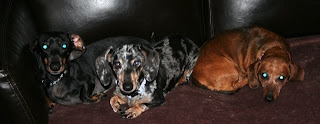 This means only one couch is left for three ridgebacks ... because no matter how large and fierce the lion hounds, no matter how bold their lion-hunting heritage, nobody but nobody messes with the owners three dachshunds. Not even me. They are vicious little critters.
This means only one couch is left for three ridgebacks ... because no matter how large and fierce the lion hounds, no matter how bold their lion-hunting heritage, nobody but nobody messes with the owners three dachshunds. Not even me. They are vicious little critters.
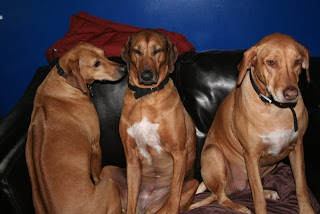 This will not do at all.
This will not do at all.
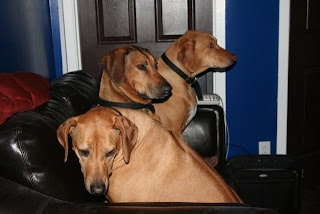 Somebody has to give. And it is not going to be Queenie or Saffron. They each outweigh Nyssa by at least thirty pounds, although they are all equally matched in that classic ridgeback trait: pig-headed stubbornness.
Somebody has to give. And it is not going to be Queenie or Saffron. They each outweigh Nyssa by at least thirty pounds, although they are all equally matched in that classic ridgeback trait: pig-headed stubbornness.
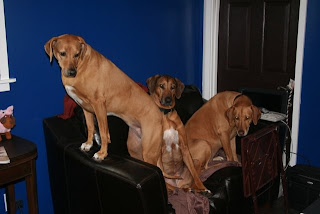 After a battle of wills lasting eons, Nyssa retreats. Radiant floor heat is of little comfort in the face of such inequity.
After a battle of wills lasting eons, Nyssa retreats. Radiant floor heat is of little comfort in the face of such inequity.
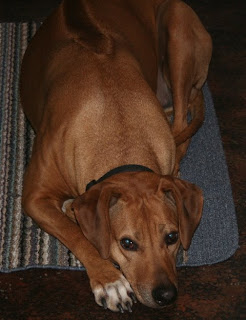
But this will not do.
4.13.2008
stew
We were sitting behind a stack of plastic Fire Chief helmets, fire-safety coloring books and a pile of brochures from volunteer applications to wildfire evacuation plans. Next to us was our department's bake sale, then the Lions Club table selling sloppy joes, nachos and soda, a free craft table, Girl Scouts selling corn dogs and hot chocolate, a coloring contest table and, looking very out of place, a white coated optometrist offering free glasses cleaning. The door was a revolving mess of kids carrying in snowballs, sawdust, sled dogs, mud and the baby bunnies somebody was selling from a dog crate outside. Every few minutes a new contest was announced. Hula-hoop. Cakewalk. Jump rope. Someone was offering face painting, and the percentage of kids with unidentifiable smears of color on their faces was increasing exponentially.
Terry told us that her son wanted to buy a pet rabbit once. She gave him the usual spiel about feeding and cleaning out his cage, then added a truly Alaskan touch. "I told him, 'If you don't take care of it, I'll feed him to you for dinner,' and he knew I wasn't kidding because his father and brothers had brought home rabbit before, and I'd cooked it. And I tell you what, I never had to tell that kid to clean out the rabbit cage twice." Good advice.
Soon it was our turn to entertain the kids. My patches were sewn on, albeit a little crooked. "Just keep moving your arm around ... nobody will notice," laughed Terry as we edged through the crowd. Instead, I put my turnout coat on over the shirt and headed outside. Terri gathered kids and did a quick check on fire safety:
"Does everyone have a reflective house number?"
"Yeeeesssss"
She eyed the parents standing behind the candy-eager crowd.
"They are free, and we have them inside. We can't find your house without one."
Back to the kids, "And what do you do if your house is on fire?"
"GET OUT AND STAY OUT," screamed the older kids. The little ones rolled in the snow.
"And what if your house if full of smoke?"
"Crawl! And GET OUT AND STAY OUT!!" Screamed the older kids. The little kids looked nervously at the firemen.
Bill and Earl were set up now, fire-hose in hand. They knelt in the snow and braced. Bill gave the signal and Jim, over at the engine, turned on the pressure. They lurched as the water slammed through the line. Bill counted down and opened the nozzle. A white spray of water and candy flew towards the snowy field ahead of us. The kids stampeded past Terri, and I dodged the back-spray snapping pictures.
I didn't bring home a bunny, although it was tempting. Peter said we would have named him Stew.
4.05.2008
symposium

 Notes from this weekend's Interior Region EMS Symposium:
Notes from this weekend's Interior Region EMS Symposium:Ankle breaks are tib-fib breaks. Splint the knee.
If a teenager needs Narcan, push it slow. Very. Very. Slow.
Do Not Ever Throw Up On Your Patient.
In a (rural, snowed-in) pinch, administer vodka and OJ for antifreeze poisoning.
In a (urban, professional) pinch, run over to the animal clinic across the street from the hospital to get the antifreeze diagnosis. Kids are mammals, too.
The CSM check they teach you in EMT-I is insufficient if there are orthopedic injuries to the limb.
40% of PICU deaths (here) result directly from abuse trauma. Ergo, if you pick up a pediatric trauma, Document Everything You See.
Five wraps around an anchor will secure the rope for anything. No knots required.
Shoulder dislocation and shoulder separation are different injuries and require different treatment. Know Before You Sling.
Don't let the vendor start talking.
Tib-Fib & Ulna-Radial fractures can dislocate proximal to the injury site. Check before you splint.
Seagulls have wing bone structure almost identical to human arm bone structure. And they are stinky.
Dress Your Knots. Or Don't.
Blue tarantulas and red-plaid fish exist in nature.
The Paramedic program will mail out acceptance & rejection notices before the end of the month.
Regardless, plans are set that will have us paddling a week of the Yukon at the end of June ... which feels more important at the moment.
4.03.2008
goose
I got through the holidays with no more escaped dogs or lockouts, and only one bite to speak of - though there were several close calls by a large-jawed Akita that I don't like to think about. As things calmed down and numbers became more manageable, I've gotten to spend more time with the dogs and gotten to know many of the regulars - and we have many. With two military bases in town, and lots of folks with jobs that take them to the bush, there are a few dogs to whom the kennel is a second home.
Duck and Goose are a couple of large husky-mutt regulars. When the first arrived this winter, I let them out to play together in the larger of the two dog-yards while I did some outside chores. They tussled and played, burned off some energy. Duck came by often to say hello and grab a pet or two before taking off to tackle Goose. When it was time to put them up, he came when I called and ran right into his kennel for a biscuit. Goose watched him go happily inside, gave me a look and took off. I spent the next two hours tryi
Once back inside, I noticed that whenever I was in the hallway, she ran outside. When I was outside, she ran in. When I let them out again (in the easier-to-manage small play yard) she played happily and ran up within a few feet of me, but never let me touch her. Goose quickly learned to go back into her run when playtime was over. Now, if I open the outside door and her run gate and walk away, she'll slip into her run and wait for me to close the door and throw her a biscuit. But if I turn around to watch her, or get between her and the exit, she'll spin and disappear outside again.
I assumed, for the two weeks they were with us, that Goose was a newly adopted dog. I assumed all kinds of abuse issues, and mentally praised the owners for taking on such a case. Duck continued to be an energetic attention lover and Goose continued to play hide-and-seek games. I was shocked, then, when Goose's people came to pick them up. Goose ran into the room with them, allowed a fleeting pet along her back as she ran past, and stood contentedly wagging her tail in a far corner. As I gathered their things and settled the bill, I asked how long they'd had Goose from the pound.
"Oh, we've had her since she was a puppy. She's been like this from day one."
I was floored. The owner went on to talk about how frustrating it is to have a dog that can't be touched, all while giving Duck a good belly-rub as he blissed out to be back with his person. Goose looked happy, barely able to contain her energy, her tail was wagging furiously.
Duck and Goose are back with us for a few weeks. Goose is back to her routine of running from play-yard to kennel as long as you aren't looking at her, and I'm back to praising the heck out of her for it, even though I all can see is her nose just barely opening the doggie-door to hear me. We've worked around her quirks, and I'm happy with that. I think she's content with the arrangement, as well. And I love their names.
There is another dog at the kennel with trust issues, a little black mutt named Pepper (the escapee of Christmas.) She was found starved and freezing by some regular clients, and instead of being turned over to the pound to her probable demise we are keeping her at the kennel until a permanent home is found. When I met Pepper, she was hand-shy and impossible to catch. We hardly ever let her loose in the yard, and never without a trailing leash we could catch her with. She's a runner, and did not trust people at all. She would tremble when petted, and avoided it at all costs. In the five months she's been around, however, she's become a different dog. She comes when calls, greets strangers with a tail wag and a proper sit, and doesn't mind being petted and loved on. She's a sweet little girl, and I hope we find her a great home.
Given my musings about entelechy, I wonder what these two quirky, hand-shy mutts have to offer to the conversation. Goose will never be cuddly dog, but she is a happy one. Pepper needed some stability, peanut butter and patience to come out of her terrified shell, but for all her progress, I can't say I think she's happy.
Subscribe to:
Posts (Atom)